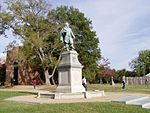The Virginia Portal  Virginia, officially the Commonwealth of Virginia, is a state in the Southeastern and Mid-Atlantic regions of the United States between the Atlantic Coast and the Appalachian Mountains. The state's capital is Richmond and its most populous city is Virginia Beach, though its most populous subdivision is Fairfax County, part of Northern Virginia, where slightly over a third of Virginia's population of 8.72 million live. The Blue Ridge Mountains cross the western and southwestern parts of the state. The state's central region lies predominantly in the Piedmont. Eastern Virginia is part of the Atlantic Plain, and the Middle Peninsula forms the mouth of the Chesapeake Bay. The fertile Shenandoah Valley fosters the state's most productive agricultural counties, while the economy in Northern Virginia is driven by technology companies and U.S. federal government agencies, including the U.S. Department of Defense and Central Intelligence Agency. Hampton Roads is also the site of the region's main seaport and Naval Station Norfolk, the world's largest naval base. (Full article...) Selected article
The Stanley plan was a package of 13 statutes adopted in September 1956 by the U.S. state of Virginia designed to ensure racial segregation in that state's public schools despite the ruling of the Supreme Court of the United States in Brown v. Board of Education of Topeka, Kansas, 347 U.S. 483 (1954). The legislative program was named for Governor Thomas B. Stanley, who proposed the program and successfully pushed for its enactment. The Stanley plan was a critical element in the policy of "massive resistance" to the Brown ruling advocated by U.S. Senator Harry F. Byrd, Sr. (pictured). The plan also included measures designed to curb the Virginia state chapter of the National Association for the Advancement of Colored People (NAACP), which many Virginia segregationists believed was responsible for "stirring up" litigation to integrate the public schools.
The plan was enacted by the Virginia Assembly on September 22, 1956, and signed into law by Governor Stanley on September 29. A federal court struck down a portion of the Stanley plan as unconstitutional in January 1957. By 1960, nearly all of the major elements of the plan (including the litigation curbs aimed at the NAACP) had been struck down by the U.S. Supreme Court and other federal and state courts. The constitutional invalidity of the Stanley plan led new governor of Virginia, James Lindsay Almond, Jr., to propose "passive resistance" to school integration in 1959. The Supreme Court declared portions of "passive resistance" unconstitutional in 1964 and again in 1968. Selected biography
Patrick Henry (May 29, 1736 – June 6, 1799) was an American attorney, planter, and orator best known for his declaration to the Second Virginia Convention (1775): "Give me liberty, or give me death!" A Founding Father, he served as the first and sixth post-colonial Governor of Virginia, from 1776 to 1779 and from 1784 to 1786.
Henry was born in Hanover County, Virginia, and became a lawyer through self-study. Beginning his practice in 1760, he soon became prominent through his victory in the Parson's Cause against the Anglican clergy. Henry was elected to the Virginia House of Burgesses, where he quickly became notable for his inflammatory rhetoric against the Stamp Act of 1765. In 1774 and 1775, Henry served as a delegate to the First and Second Continental Congresses, but did not prove particularly influential. He gained further popularity among the people of Virginia, both through his oratory at the convention and by marching troops towards the colonial capital of Williamsburg after the Gunpowder Incident until the munitions seized by the royal government were paid for. Henry urged independence, and when the Fifth Virginia Convention endorsed this in 1776, served on the committee charged with drafting the Virginia Declaration of Rights and the original Virginia Constitution. Henry was promptly elected governor under the new charter, and served a total of five one-year terms. After leaving the governorship in 1779, Henry served in the Virginia House of Delegates until he began his last two terms as governor in 1784. The actions of the national government under the Articles of Confederation made Henry fear a strong federal government and he declined appointment as a delegate to the 1787 Constitutional Convention. He actively opposed the ratification of the Constitution, a fight which has marred his historical image. He returned to the practice of law in his final years, declining several offices under the federal government. Henry is remembered for his oratory, and as an enthusiastic promoter of the fight for independence. This month in Virginia history
Random Virginia articleA random generator will select an article about… 
(note: generator may be slow) Things you can do
Tasks
Selected image Little Joe 1 rocket being prepared for a test flight at NASA's Wallops Flight Facility on the Eastern Shore, as part of Project Mercury, 1959 Did you know -
Fact sheet
State symbols:
Government
Related portalsVirginia topicsSubcategoriesSelect [+] to view subcategories
Associated WikimediaThe following Wikimedia Foundation sister projects provide more on this subject:
Discover Wikipedia using portals |


























